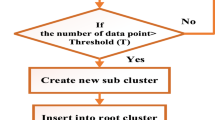Abstract
This work develops a novel indicator-based multi-objective bacterial colony foraging algorithm (I-MOBCA) for complex multi-objective or many-objective optimization problems. The main idea of I-MOBCA is to develop an adaptive and cooperative model by combining bacterial foraging, adaptive searching, cell-to-cell communication and preference indicator-based measure strategies. In this algorithm, each bacterium can adopt its run-length unit to appropriately balance exploitation and exploration states, and the quality of position or solution is calculated on the basis of the binary quality indicator to determine the Pareto dominance relation. Our algorithm uses Pareto concept and preference indicator-based measure to determine the non-dominated solutions in each generation, which can essentially reduce the computation complexity. With several mathematical benchmark functions, I-MOBCA is proved to have significantly better performance over compared algorithms for solving some complex multi-objective optimization problems. Then the proposed I-MOBCA is used to solve three-objective RFID network planning problem. Simulation results show that I-MOBCA proves to be superior for planning RFID networks than compared algorithms in terms of optimization accuracy and computation robustness.
Similar content being viewed by others
References
Zitzler, E., Künzli, S.: Indicator-based selection in multiobjective search. Lect. Notes Comput. Sci. 3242, 832–842 (2004)
Jia, L., Cheng, D., Chiu, M.S.: Pareto-optimal solutions based multi-objective particle swarm optimization control for batch processes. Neural Comput. Appl. 21(6), 1107–1116 (2012)
Buche, D., Schraudolph, N.N., Koumoutsakos, P.: Accelerating evolutionary algorithms with Gaussian process fitness function models. IEEE Trans. Syst. Man Cybern. Part C 35(2), 183–194 (2005)
Yang, X.S.: Swarm intelligence based algorithms: a critical analysis. Evol. Intell. 7(1), 17–28 (2014)
Akay, B.: Synchronous and asynchronous Pareto-based multi-objective Artificial Bee Colony algorithms. J. Glob. Optim. 57(2), 415–445 (2013)
Gong, M., Jiao, L., Du, H., et al.: Multiobjective immune algorithm with nondominated neighbor-based selection. Evol. Comput. 16(2), 225–255 (2008)
Muller, S.D., Marchetto, J., Airaghi, S., et al.: Optimization based on bacterial chemotaxis. IEEE Trans. Evol. Comput. 6(1), 16–29 (2002)
Bermejo, E., Cordón, O., Damas, S., et al.: A comparative study on the application of advanced bacterial foraging models to image registration. Inf. Sci. 295, 160–181 (2015)
Yi, J., Huang, D., Fu, S., et al.: Multi-objective bacterial foraging optimization algorithm based on parallel cell entropy for aluminum electrolysis production process. IEEE Trans. Ind. Electron. 63(4), 2488–2500 (2016)
Deb, K., Pratap, A., Agarwal, S., et al.: A fast and elitist multiobjective genetic algorithm: NSGA-II. IEEE Trans. Evol. Comput. 6(2), 182–197 (2002)
Kim, M., Hiroyasu, T., Miki, M., et al.: SPEA2+: improving the performance of the strength Pareto evolutionary algorithm 2. Lect. Notes Comput. Sci. 3242(4), 742–751 (2004)
Verma, O.P., Hanmandlu, M., Sultania, A.K., et al.: A novel fuzzy system for edge detection in noisy image using bacterial foraging. Multidimens. Syst. Signal Process. 24(1), 181–198 (2013)
Gao, L., Barrett, D., Chen, Y., et al.: A systems model combining process-based simulation and multi-objective optimisation for strategic management of mine water. Environ. Modell. Softw. 60(7), 250–264 (2014)
Li, Y., Liu, F.: A novel immune clonal algorithm. IEEE Trans. Evol. Comput. 16(1), 35–50 (2012)
Sundaresan, S., Doss, R., Zhou, W.: A secure search protocol based on Quadratic Residues for EPC Class-1 Gen-2 UHF RFID tag. In: Proceedings 2012 IEEE 23rd International Symposium on Personal Indoor and Mobile Radio Communications (PIMRC), pp. 30–35 (2012)
Cho, J., Shim, Y., Kwon, T., et al.: SARIF: a novel framework for integrating wireless sensor and RFID networks. IEEE Wirel. Commun. 14(6), 50–56 (2007)
Guo, D.L., Xiang, Q., Li, Z.H.: Hybrid intelligent optimization approach for RFID network planning. Appl. Mech. Mater. 596(596), 230–233 (2014)
Hsu, C.H., Chen, S.C., Yu, C.H., et al.: Alleviating reader collision problem in mobile RFID networks. Pers. Ubiquitous Comput. 13(7), 489–497 (2009)
Chen, H., Zhu, Y., Hu, K., et al.: RFID network planning using a multi-swarm optimizer. J. Netw. Comput. Appl. 34(3), 888–901 (2011)
Gandino, F., Ferrero, R., Montrucchio, B., et al.: Probabilistic DCS: an RFID reader-to-reader anti-collision protocol. J. Netw. Comput. Appl. 34(3), 821–832 (2011)
Tetta, C., Ghigo, E., Silengo, L., et al.: Extracellular vesicles as an emerging mechanism of cell-to-cell communication. Endocrine 44(1), 11–19 (2013)
Zhong, Y.B., Xiang, Y., Liu, H.L.: A multi-objective artificial bee colony algorithm based on division of the searching space. Appl. Intell. 41(4), 987–1011 (2014)
Acknowledgements
This work is supported by National key Research and Development Plan of China under Grant No.(2016YFB1100501, 2017YFB1103603, 2017YFB1103603), National Natural Science Foundation of China under Grant No. (61772365, 41772123, 61602343, 51607122, 51575158, 51378350 and 51305167), Tianjin Province Science and Technology Projects under Grant No. (16ZLZDZF00150, 17JCQNJC04500, 17JCYBJC15100) and Basic Scientific Research Business Funded Projects of Tianjin (TJPUZK20170128, TJPUZK20170129).
Author information
Authors and Affiliations
Corresponding author
Appendix
Rights and permissions
About this article
Cite this article
Yuan, C., Hanning, C., Shen, J. et al. Indicator-based multi-objective adaptive bacterial foraging algorithm for RFID network planning. Cluster Comput 22 (Suppl 5), 12649–12657 (2019). https://doi.org/10.1007/s10586-018-1715-0
Received:
Revised:
Accepted:
Published:
Issue Date:
DOI: https://doi.org/10.1007/s10586-018-1715-0




